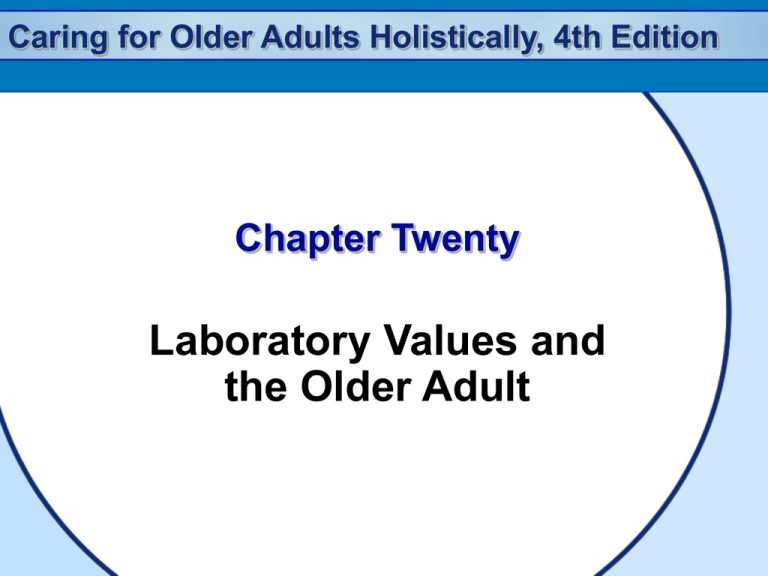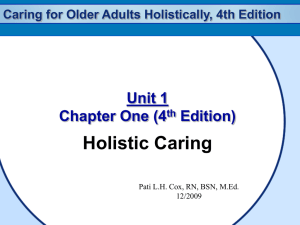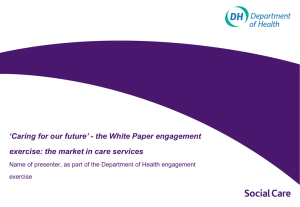Chapter Twenty
advertisement

Caring for Older Adults Holistically, 4th Edition Chapter Twenty Laboratory Values and the Older Adult Caring for Older Adults Holistically, 4th Edition Meaning of Laboratory Values Many normal ranges are different for older adults Greater deviation from normal when under stress Return to normal is slower Relationship to clinical status Lab values should be evaluated in relationship to individual’s entire clinical situation Abnormal lab value may indicate a clinical stressor or medication side effect rather than illness Caring for Older Adults Holistically, 4th Edition Meaning of Laboratory Values Routine laboratory evaluations Complete blood cell count Serum glucose Serum creatinine level Serum electrolytes Thyroid function tests Urinalysis Stool guaiac test Caring for Older Adults Holistically, 4th Edition Common Screening Tests Tuberculin skin test Negative result <10 mm of induration Screening method for tuberculosis May need to be repeated 1 week later Urinalysis Appearance—clear yellow/straw Specific gravity—1.005–1.020 pH—4.5–8.0 Negative for glucose, ketones, blood, bilirubin Caring for Older Adults Holistically, 4th Edition Common Screening Tests Urinalysis (cont.) Types of specimens Mid-stream clean catch Fasting 24-hour Send specimen to lab within 10 minutes or keep refrigerated Caring for Older Adults Holistically, 4th Edition Common Screening Tests Stool for occult blood Negative result—absence of test color Test three specimens and two different sections of each stool Avoid red meat, vitamin C intake, iron supplements, and aspirin 2 to 3 days before and during stool collection Caring for Older Adults Holistically, 4th Edition Hematological Indicators Complete blood count Values do not change with age Red blood cell count Men—5.4 ± 0.9 × 1012/L Women—4.8 ± 0.6 × 1012/L Diagnose anemia, polycythemia, other bone marrow abnormalities Caring for Older Adults Holistically, 4th Edition Hematological Indicators Complete blood count (cont.) Hemoglobin Men—14–18 g/dL Women—12–16 g/dL Increase—polycythemia, dehydration Decrease—anemia, recent hemorrhage, fluid retention, kidney disease Caring for Older Adults Holistically, 4th Edition Hematological Indicators Complete blood count (cont.) Hematocrit Men—47.0 ≠ 5.0% Women—42.0 ≠ 5.0% Measures percentage by volume or packed RBC in whole blood Increased—polycythemia Decreased—anemia, hemodilution, bone marrow disease Caring for Older Adults Holistically, 4th Edition Hematological Indicators Complete blood count (cont.) RBC indices MCV 90 ± 7 fl MCH 29 ± 2 pg MCHC 34 ± 2% Aid in diagnosis and classification of anemias Caring for Older Adults Holistically, 4th Edition Hematological Indicators Complete blood count (cont.) White blood cell count 4.5–11.0 ×109/L Used to identify infectious or inflammatory processes, monitor response to chemotherapy and radiation therapy Increased—infection, leukemia, inflammation Decreased—bone marrow depression, viral infection Caring for Older Adults Holistically, 4th Edition Hematological Indicators Complete blood count (cont.) White blood cell differential Neutrophils 1.8–7.7 ×109/L or 30%–60% Eosinophils 0–0.45 ×109/L or 1%–4% Basophils 0–0.20 ×109/L or 0%–0.5% Lymphocytes 1.0–4.8 ×109/L or 25%–35% Monocytes 0–0.8×109/L or 1%–4.0% Caring for Older Adults Holistically, 4th Edition Hematological Indicators Complete blood count (cont.) White blood cell differential (cont.) Used to determine severity of infection, detect allergic reactions, identify various leukemias Caring for Older Adults Holistically, 4th Edition Hematological Indicators Complete blood count (cont.) Platelet count 130,000–400,000/mL Required for clot formation and hemostasis Increased—iron-deficiency anemia, hemorrhage, malignancies, splenectomy Decreased—bone marrow disease, folic acid or vitamin B12 deficiency, drug side effects Caring for Older Adults Holistically, 4th Edition Hematological Indicators Complete blood count (cont.) Coagulation Prothombin time Normal: 9.5–11.8 s (control ±1 s) Therapeutic: 1.5–2.0 times normal control Determined before anticoagulation therapy and monitored throughout therapy Caring for Older Adults Holistically, 4th Edition Hematological Indicators Complete blood count (cont.) Coagulation Activated partial thromboplastin time (APTT) Normal: 25–36 s Therapeutic: 1.5–2.5 times normal control Evaluated clotting factors of the intrinsic pathway Caring for Older Adults Holistically, 4th Edition Blood Chemistry Indicators Blood glucose Fasting: Normal: 75–115 mg/dL Diabetes mellitus: 140 mg/dL on at least two occasions Two hours after eating: Normal: 140 mg/dL Impaired glucose tolerance: 140–200 mg/dL Diabetes mellitus: >200 mg/dl on at least two occasions Caring for Older Adults Holistically, 4th Edition Blood Chemistry Indicators Blood glucose (cont.) Decreased—side effects of various medications, strenuous exercise Increased—medication side effects, recent illness or infection Electrolytes Sodium 136–145 mEq/L Caring for Older Adults Holistically, 4th Edition Blood Chemistry Indicators Electrolytes (cont.) Sodium (cont.) Hyponatremia Caused by vomiting, diarrhea, renal disorders, diuretics, congestive heart failure Hypernatremia Caused by inadequate fluid intake, diarrhea, diuretics Caring for Older Adults Holistically, 4th Edition Blood Chemistry Indicators Electrolytes (cont.) Potassium 3.5–5.0 mEq/L Hypokalemia Caused by diuretics, malnutrition, vomiting, diarrhea Hyperkalemia Caused by renal failure, injuries, acidosis, diabetes mellitus, several medications Caring for Older Adults Holistically, 4th Edition Blood Chemistry Indicators Electrolytes (cont.) Calcium 9–10.5 mg/dL Hypocalcemia Caused by hypoparathyroid, laxative, chemotherapy, corticosteroids Hypercalcemia Caused by hyperparathyroid, thiazide antidiuretics, immobilization, excessive vitamin D, calcium-containing antacids Caring for Older Adults Holistically, 4th Edition Blood Chemistry Indicators Electrolytes (cont.) Phosphate 3–4.5 mg/dL Chloride 98–106 mEq/L End products of metabolism Blood urea nitrogen (BUN) 10–20 mg/dL Increased caused by renal disease, urinary tract obstruction, drugs Caring for Older Adults Holistically, 4th Edition Blood Chemistry Indicators End products of metabolism (cont.) Blood urea nitrogen (cont.) Decrease caused by severe liver failure, malnutrition, overhydration Creatinine <1.5 mg/dL Increase caused by renal disease, diabetic acidosis, starvation, diuretics High levels indication of renal failure Caring for Older Adults Holistically, 4th Edition Blood Chemistry Indicators End products of metabolism (cont.) Bilirubin Total: 0.3–1.0 mg/dL Direct: 0.1–0.3 mg/dL Indirect: 0.2–0.7 mg/dL Uric acid Men: 2.5–8.0 mg/dL Women: 1.5–6.0 mg/dL Increase caused by loop diuretics, thiazides, starvation, alcohol abuse, chemotherapy Caring for Older Adults Holistically, 4th Edition Blood Chemistry Indicators Liver function tests ALT 0–35 U/L Increase caused by liver disease, medications, cholecystitis, trauma, lead ingestion AST or SGOT 0–35 U/L Increase caused by myocardial infarction, liver disease, hemolytic anemia, pulmonary emboli Caring for Older Adults Holistically, 4th Edition Blood Chemistry Indicators Liver function tests LDH 60–100 U/mL Caring for Older Adults Holistically, 4th Edition Nutritional Indicators Protein indicators Total serum protein 5.5–8.0 g/dL Increase caused by dehydration, infection, diabetic acidosis, chronic alcoholism Decreased caused by malnutrition, hepatic disease, renal disease, congestive heart failure Albumin 3.5–5.5 g/dL Increased caused by multiple myeloma Decreased caused by malnutrition, liver and renal disease, collagen diseases, rheumatoid arthritis Caring for Older Adults Holistically, 4th Edition Nutritional Indicators Globulins 2.0–3.0 g/dL Increase caused by tuberculosis, chronic syphilis, subacute bacterial endocarditis, myocardial infarction, diabetes mellitus Iron indicators Iron: Men 80–180 mg/dL Women 60–160 mg/dL Essential in production and function of hemoglobin Caring for Older Adults Holistically, 4th Edition Nutritional Indicators Iron indicators (cont.) Ferritin 15–200 ng/mL Increased in hepatic disease, iron overload, leukemia, chronic renal disease Decreased in chronic iron deficiency Total iron-binding capacity 250–460 mg/dL Caring for Older Adults Holistically, 4th Edition Nutritional Indicators Lipoproteins Total plasma cholesterol Desired <200 mg/dL Borderline 200–239 mg/dL High 240 mg/dL High-density lipoprotein HDL Desired >35 Caring for Older Adults Holistically, 4th Edition Nutritional Indicators Lipoproteins Low-density lipoprotein (LDL) Desired 130 mg/dL Borderline 130–159 mg/dL High 160 mg/dL Triglycerides 160 mg/dL Caring for Older Adults Holistically, 4th Edition Nutritional Indicators Lipoproteins Lipid abnormalities are often familial Secondary causes Diets high in saturated fat or cholesterol Excessive alcohol intake Estrogen supplements Smoking Sedentary lifestyle Caring for Older Adults Holistically, 4th Edition Nutritional Indicators Lipoproteins Cholesterol is decreased in malnutrition, hyperthyroidism and chronic obstructive pulmonary disease Caring for Older Adults Holistically, 4th Edition Drug Monitoring and Toxicology Drug monitoring is important when toxic and therapeutic range is narrow Commonly monitored drugs Digoxin Therapeutic: 0.5–20 ng/mL Toxic: 2.5 ng/mL Signs of toxicity Visual changes, headache, nausea and vomiting, weakness and fatigue Caring for Older Adults Holistically, 4th Edition Drug Monitoring and Toxicology Commonly monitored drugs (cont.) Theophylline Therapeutic: 10–20 µg/mL Toxic: 20 µg/mL Signs of toxicity Anorexia, abdominal discomfort, dizziness, shakiness, restlessness, palpitation, tachycardia, hypotension Caring for Older Adults Holistically, 4th Edition Drug Monitoring and Toxicology Commonly monitored drugs (cont.) Phenytoin Therapeutic: 10–20 µg/mL Toxic: 30 µg/mL Signs of toxicity Drowsiness, mental confusion, tremors, photophobia, blurred vision







